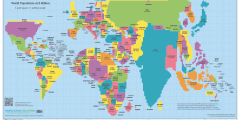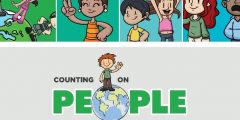Hi, I’m Pam. And today, I’d like to introduce you to an activity called Lessons for Life. The subject of this activity is girls’ equal access to education, and why that’s important. Not just for the well-being of the girl herself, but also to a country’s development. And to a stable population.
This is a great activity for broadening awareness among students about the lives of kids in other parts of the world. They’re going to find that, while they take it for granted that they’ll complete high school and maybe even college, for children in many parts of the globe, but especially girls, that’s not a given.
This is a middle school activity. It’s excellent for social studies and also, English language arts.
There are three primary objectives for this activity, one is to name two barriers and two benefits to girls attending school. The second is to identify the links between female education and population growth, through text evidence and graphic data. The third objective is to discuss and analyze two poems related to girls’ education, examining various elements such as voice, meaning and mood. The materials for this activity include a reading, a worksheet, and a poem, which are provided, and internet access in your classroom.
Part 1 is called “Educating Abeba.” This is a short dialogue for the students to read between two girls in Ethiopia Abeba her friend Rediet. We find that Abeba had to leave school. This was her parents’ decision because they needed her at home to help care for younger siblings, and take care of the household chores. Rediet is in school and her parents decided it’s important for her to stay in school, in order to have more opportunities later in life. In the dialogue, the girls talk about what their day-to-day life is like one in school and one at home.
Then the students will complete a worksheet. The first part of the worksheet, includes comprehension questions, understanding who the girls are and what their parents have decided for them. And then extending that to understanding what their prospects might be in the future. For instance, which of the two girls might marry and at what age, and how many children might they have?
One of the questions deals with a proverb that Rediet’s mother has told her: “Educate a boy and you educate one person. Educate a girl, and you educate a nation.” This is a good discussion starter for the class. What did Rediet’s mother mean by that, and do the students agree with that?
The second part of the worksheet, has the students interpret a graph. On one side there are bars showing the average years of schooling for girls in several different countries. The other side of the bar shows the number of children, on average, that women have in those same countries. Students can make some correlations based on what they see on the graph. And you might lead a discussion with students on the cause and effect between years of schooling and completed family size.
Part 2 of the activity is called “In Their Own Words” and focuses on two poems – “Eunice’s Dream: A Poem from Kibera School for Girls” by Eunice Akoth, and “The Power of Firsts” by Amanda Gorman, the first-ever Youth Poet Laureate in the U.S. “Eunice’s Dream” is printed out on the lesson pdf and there’s a link to a video of Eunice reciting it. There’s a link to “The Power of Firsts,” which Gorman wrote for the International Day of the Girl in 2017.
There are some class discussion questions comparing and contrasting the two poems and assessing the meaning of certain phrases. After the group discussion, students select one of the poems to analyze, using the provided worksheet. They will describe the point of view of the author, the meaning of the poem, what images come to mind when they read the poem, and the mood that the poem evokes. After that, students have a chance to analyze some of the poems’ literary devices including simile, metaphor, personification, and imagery. This makes for a great way to combine ELA skills with social studies themes.
We have similar activities for different grade levels. One is called A Woman’s Place and is geared toward high school students.
This and other activities can be found on our website www.populationeducation.org.






